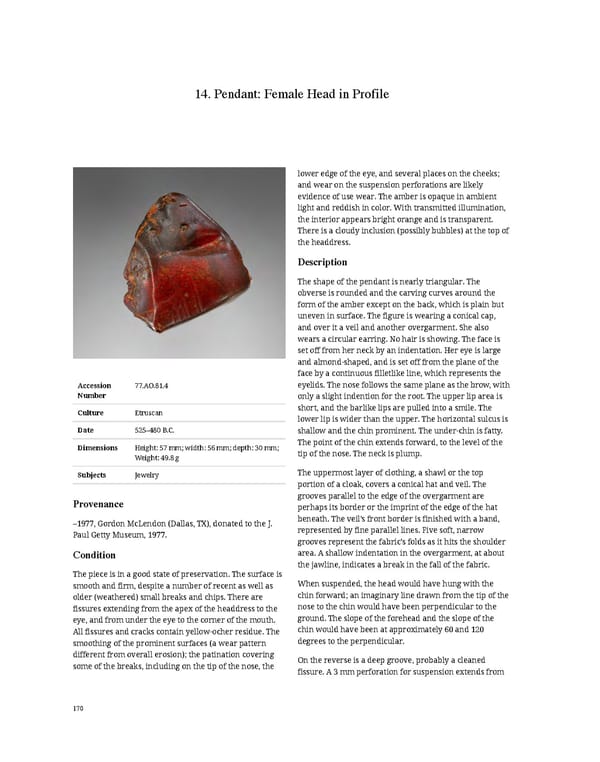14. Pendant: Female Head in Profile lower edge of the eye, and several places on the cheeks; and wear on the suspension perforations are likely evidence of use wear. The amber is opaque in ambient light and reddish in color. With transmitted illumination, the interior appears bright orange and is transparent. There is a cloudy inclusion (possibly bubbles) at the top of the headdress. Description The shape of the pendant is nearly triangular. The obverse is rounded and the carving curves around the form of the amber except on the back, which is plain but uneven in surface. The figure is wearing a conical cap, and over it a veil and another overgarment. She also wears a circular earring. No hair is showing. The face is set off from her neck by an indentation. Her eye is large and almond-shaped, and is set off from the plane of the face by a continuous filletlike line, which represents the Accession 77.AO.81.4 eyelids. The nose follows the same plane as the brow, with Number only a slight indention for the root. The upper lip area is Culture Etruscan short, and the barlike lips are pulled into a smile. The lower lip is wider than the upper. The horizontal sulcus is Date 525–480 B.C. shallow and the chin prominent. The under-chin is fatty. Dimensions Height: 57 mm; width: 56 mm; depth: 30 mm; The point of the chin extends forward, to the level of the Weight: 49.8 g tip of the nose. The neck is plump. Subjects Jewelry The uppermost layer of clothing, a shawl or the top portion of a cloak, covers a conical hat and veil. The Provenance grooves parallel to the edge of the overgarment are perhaps its border or the imprint of the edge of the hat –1977, Gordon McLendon (Dallas, TX), donated to the J. beneath. The veil’s front border is finished with a band, Paul Getty Museum, 1977. represented by fine parallel lines. Five soft, narrow grooves represent the fabric’s folds as it hits the shoulder Condition area. A shallow indentation in the overgarment, at about the jawline, indicates a break in the fall of the fabric. The piece is in a good state of preservation. The surface is smooth and firm, despite a number of recent as well as When suspended, the head would have hung with the older (weathered) small breaks and chips. There are chin forward; an imaginary line drawn from the tip of the fissures extending from the apex of the headdress to the nose to the chin would have been perpendicular to the eye, and from under the eye to the corner of the mouth. ground. The slope of the forehead and the slope of the All fissures and cracks contain yellow-ocher residue. The chin would have been at approximately 60 and 120 smoothing of the prominent surfaces (a wear pattern degrees to the perpendicular. different from overall erosion); the patination covering On the reverse is a deep groove, probably a cleaned some of the breaks, including on the tip of the nose, the fissure. A 3 mm perforation for suspension extends from 170
 Ancient Carved Ambers in the J. Paul Getty Museum Page 179 Page 181
Ancient Carved Ambers in the J. Paul Getty Museum Page 179 Page 181